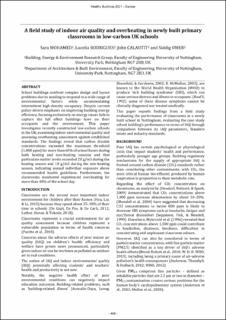A field study of indoor air quality and overheating in newly built primary classrooms in low-carbon UK schools
Chapter, Peer reviewed, Conference object
Published version
Permanent lenke
https://hdl.handle.net/11250/2976097Utgivelsesdato
2021Metadata
Vis full innførselSamlinger
- SINTEF Proceedings [402]
Sammendrag
School buildings confront complex design and layout problems due to needing to respond to a wide range of environmental factors while accommodating intermittent high-density occupancy. Despite current policy-driven emphases on improving building energy efficiency, focusing exclusively on energy issues fails to capture the full effect buildings have on their occupants and the environment. This paper investigates recently constructed low-carbon schools in the UK, examining indoor environmental quality and assessing overheating assessment against established standards. The findings reveal that carbon dioxide concentrations exceeded the maximum threshold (1,000 ppm) for more than 60% of school hours during both heating and non-heating seasons and that particulate matter levels exceeded 20 g/m3 during the heating season and 10 g/m3 during the non-heating season, indicating annual individual exposure above recommended health guidelines. Furthermore, the classrooms monitored experienced overheating for more than 40% of the school day.

